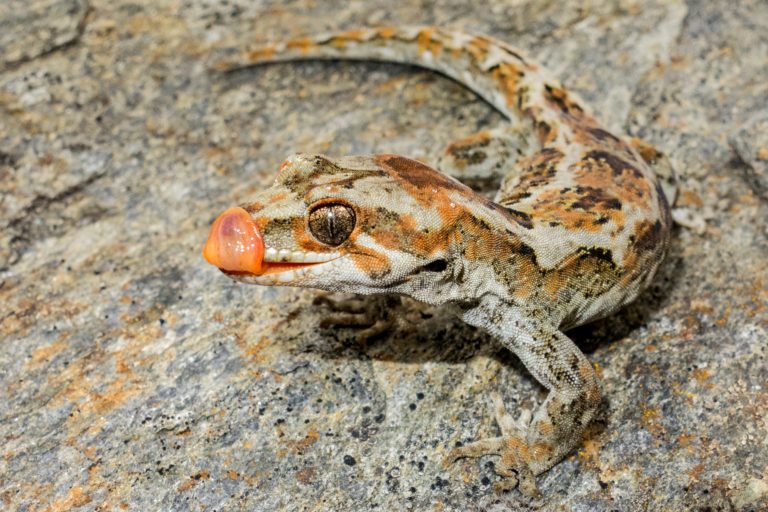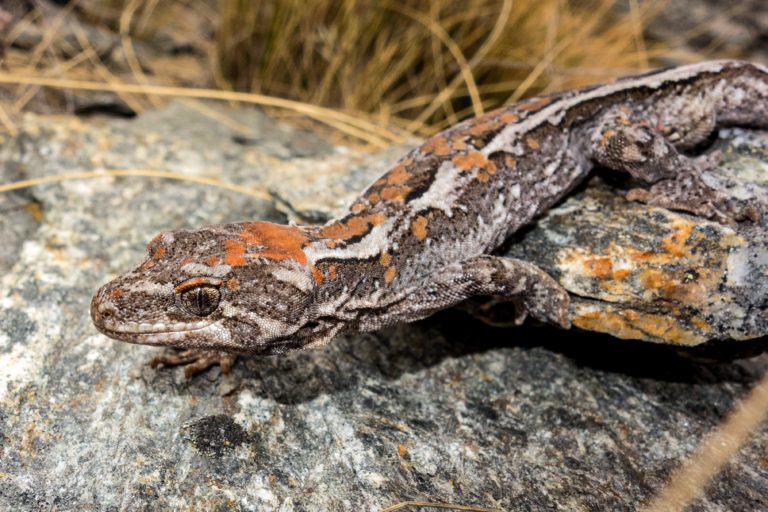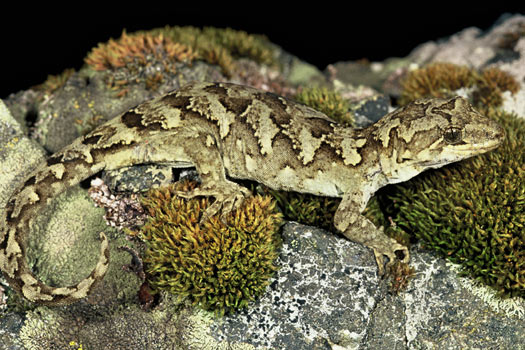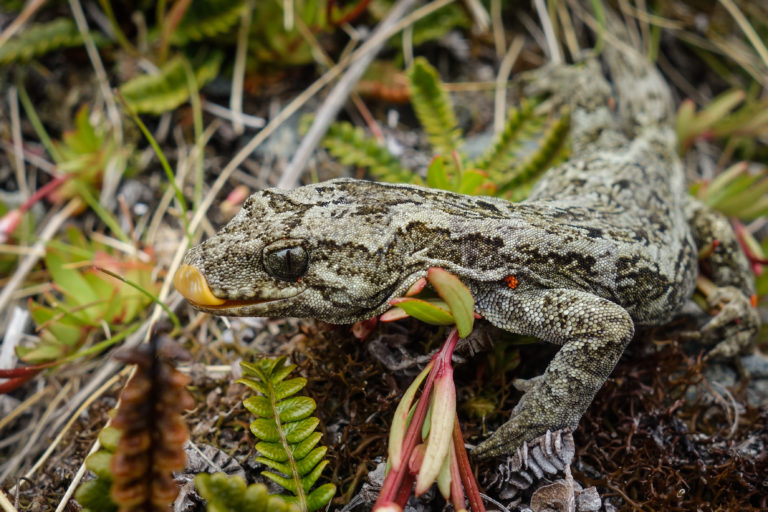There’s a rare and colourful gecko known to live in only a few boulder fields and rock jumbles in the alpine areas of Queenstown Lakes and Central Otago districts. It’s been named the orange-spotted gecko and was only discovered as recently as 1998.
Note: We are re-sharing our articles. This article was originally published on September 26, 2019.

Not surprisingly, very little is known about the orange-spotted gecko – but leading New Zealand herpetologists Carey Knox, Tony Jewel and Joanne Monks have been checking these rare reptiles out and report what they’ve discovered in a paper just published in the New Zealand Journal of Ecology.
“New Zealand’s mountainous environments support unique flora and fauna specially adapted to the extreme cold and harsh conditions of the alpine zone. The orange-spotted gecko (Mokopirirakau “Roys Peak”) is a rare undescribed gecko that is currently known only from the alpine zone of Otago, with populations spanning a ~ 3000 km2 area.”
To study them, the researchers first had to find them and trialled several different detection methods as part of their search.

“We aimed to improve knowledge of orange-spotted geckos by collating existing survey data, assessing abundance and distribution at known sites, collecting biological data, comparing detection methods, and searching for new populations. Search techniques involved rock-lifting and spotlighting at night.”
Other lizard species have also been identified as living in our alpine zones, but it is a challenging habitat for a cold-blooded species.
“In New Zealand, alpine areas are a significant component of the landscape covering c. 11% of the land area. Alpine New Zealand has a reasonably diverse lizard fauna, with at least 13 gecko and 17 skink species extending into alpine areas (out of 106 described and undescribed lizard taxa).”
Five of those 30 species have only been recorded in the alpine zone, but others may once have been present at lower altitudes and affected by habitat modification and/or introduced mammal predators.
“Other species formerly considered to be alpine specialists have been discovered at low elevations (e.g. in forested environments), suggesting that the alpine zone provides refugia for some formerly widespread species, for example, the Takitimu gecko (Mokopirirakau cryptozoicus).”

So what is currently known about the orange-spotted gecko?
“The orange-spotted gecko is a secretive, largely nocturnal and saxicolous [ie lives amongst rocks] gecko, and appears to be confined to mountainous areas of central and western Otago. The orange-spotted gecko was first discovered in 1998 and currently has a threat ranking of ‘Nationally Vulnerable’. As with many cryptic and poorly known species, there is some uncertainty surrounding this threat status, due to a lack of information on abundance and distribution across their known range.”
According to current records, orange-spotted geckos occupy a minimum altitudinal range of 1150–1620 m above sea level (a.s.l.).
“The one specimen found at a much lower altitude in a garden rock wall at 500 m a.s.l. may have been translocated there by children from a nearby mountain.”
At lower altitudes, the orange-spotted gecko has potential competition from a family of geckos from the genus Woodworthia.
“At altitudes below 1150 m a.s.l., Woodworthia geckos (e.g. the Southern Alps gecko, Woodworthia “Southern Alps”, or korero gecko, Woodworthia “Otago/Southland large”) often use similar rocky retreats. It is not known to what degree orange-spotted geckos can co-exist with the different Woodworthia species in rocky habitats at low-moderate altitudes, although overlap with the much smaller Southern Alps gecko has been noted at one site.”
Orange-spotted geckos have been found at only a small number of isolated rocky-habitat sites.
“From 1998–2007 approximately 35 individual orange-spotted geckos were located across five sites in the QueenstownLakes and Central Otago districts, with populations spanning across an approximate 3000 km2 area. Each site appears to be no more than 20 hectares in size, based on the extent of suitable rocky habitat, and is isolated from all other known sites. Only 1–3 individual geckos were found at three of these sites. Five different populations reduces the perceived risk of extinction; however, the species remains poorly understood and known from few specimens.”

Carey Knox, Tony Jewel and Joanne Monks found a large population at one site (Queenstown-Lakes A) where 95 orange-spotted geckos were recorded.
“All other populations (n = 5) appeared small with 20 or fewer geckos found, but require further surveying to better understand numbers and distribution.”
Being cold-blooded in an alpine habitat may mean that females have a long gestation period.
“Females examined contemporaneously exhibited a range of reproductive conditions, suggesting production of successive progeny may take 2 or more years. Most pregnant geckos (32 of 35) were carrying two embryos.”
It may also take as long as 4 years for young geckos to reach breeding maturity.
The researchers trialled several detection methods but simply lifting rocks seems to work best.
“We trialled two detection methods on orange-spotted geckos: double-layered single corrugation Onduline retreats and tracking cards installed in small tunnels among suitable habitat; neither method had previously been trialled on alpine Mokopirirakau geckos. In addition, we continued with spotlighting and rock-lifting (methods that have yielded sightings in the past) to help us assess population numbers and distribution. Surveys took place at eight sites over 2015–2017. In addition, data from a further three sites that were surveyed between 2002 and 2007 are included. Due to the high potential risk of poaching we have avoided making any references to exact localities.”
“Across the six sites where orange-spotted geckos were located, the vast majority (129 geckos) were found by rock lifting during 218 person hours of searching. Geckos were found under rocks in a range of weather conditions (dry weather with temperatures between 13°C and 22°C). Some warmth from the sun on the rocks appeared to increase catch per unit effort (CPUE). When rain fell CPUE appeared to decrease (e.g. only one was found from 10 person hours (PH) across two days with persistent rain at QL-A), suggesting that the geckos may have retreated away from surface rocks to beneath boulders that were too heavy to lift. Night-time temperatures during our surveys were generally low (7–8°C) and suboptimal for emergence of geckos.”

The areas where the geckos were found are snow-covered for 3-4 months every year.
“All habitats surveyed for orange-spotted geckos were in the Central Otago or Queenstown-Lakes alpine zone. They comprised the steep upper slopes of mountains with extensive exposed rock from 1000–1800 m above sea level. Rocky habitats surveyed for geckos can be described as alpine boulder fields, rocky bluffs, scree slopes, and loose rock aggregations. Snow cover is normally present for 3–4 months of the year. Vegetation was typically dominated by Chionochloa rigida, with a wide range of intersecting mat-forming plants and alpine shrubs growing around and between rocks.”
There is still much to learn about the rare and beautiful orange-spotted geckos. Threats to remaining populations may include predation by introduced mammals, habitat modification, illegal collection, and climate change.
“Given the orange-spotted geckos slow life history traits, (only producing young every 2 or more years and probably taking over 4 years to reach maturity), predation by introduced mammals (if frequent enough) may be a significant threat. In addition, climate change could enable more species of mammalian predators, or higher densities of predators, to infiltrate the alpine zone from lower slopes.”
“Future priorities for New Zealand’s alpine geckos include undertaking more research on how to monitor populations, evaluating reproductive cycles at different altitudes, and assessing whether predators and other factors threaten population viability. Genetic analyses could test whether populations have been recently isolated, or whether there is a long history of fragmentation.”
The full research paper has been published in the New Zealand Journal of Ecology and is freely available online.

